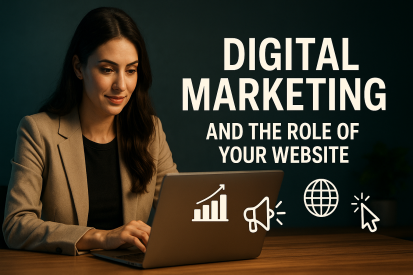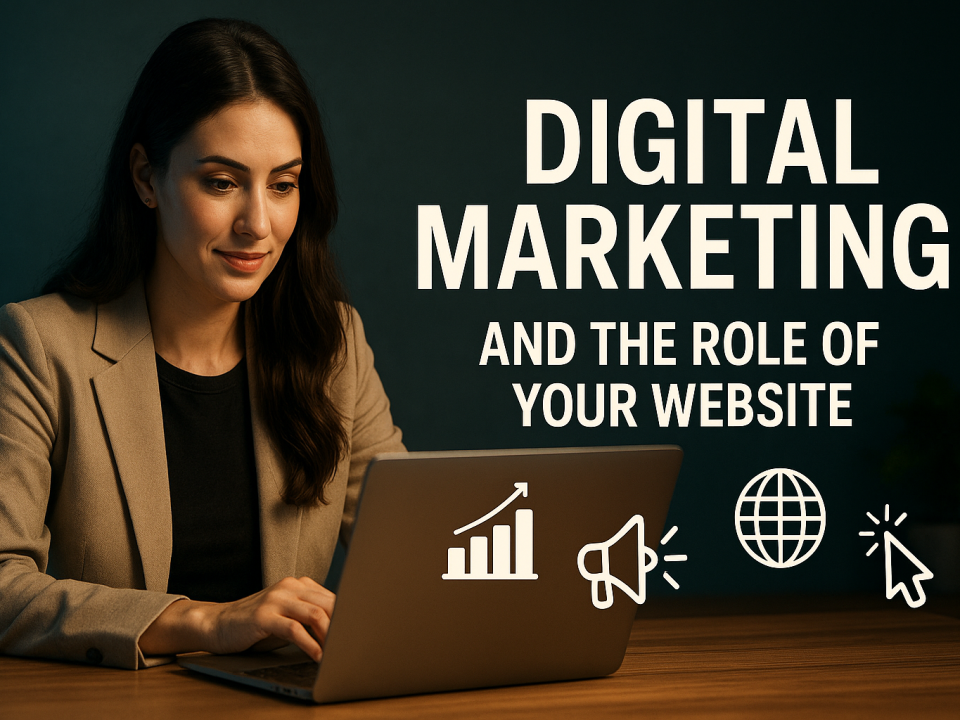
Introduction
In today’s fast-paced digital world, your website is more than just an online address — it’s the beating heart of your digital marketing strategy. Whether you’re a startup or an established enterprise, your website serves as the central hub where all marketing efforts converge. It’s where visitors land, leads are generated, and conversions happen.
But here’s the truth: having a website isn’t enough anymore. You need a website that works in harmony with your overall marketing strategy — one that’s optimized for user experience (UX), SEO, and conversions. In this article, we’ll dive deep into the role of your website in digital marketing, why it matters, and how to make it your most powerful online asset.
The Website: Your Digital Headquarters
Every brand’s digital ecosystem revolves around one thing — its website. Think of it as your virtual storefront, open 24/7, representing your brand identity to the world.
Why Your Website Matters
- First Impression Counts: 75% of users judge a company’s credibility based on its website design.
- Conversion Engine: It’s where ads, emails, and social media campaigns lead.
- Owned Asset: Unlike social media platforms, your website is something you fully control.
A well-structured website connects all your marketing channels — SEO, email marketing, paid ads, and social media — into one cohesive system.
How Digital Marketing and Websites Work Together
1. SEO: Driving Organic Visibility
Your website is the foundation of Search Engine Optimization (SEO). By optimizing pages for keywords, metadata, and mobile responsiveness, you increase visibility on Google and attract targeted traffic.
SEO Key Elements:
- On-page SEO: Title tags, meta descriptions, and structured data.
- Off-page SEO: Backlinks and content partnerships.
- Technical SEO: Fast load times, SSL security, and XML sitemaps.
Example: A local bakery optimized its website for “fresh cakes near me,” resulting in a 40% increase in foot traffic and online orders.
2. Content Marketing: Building Authority
Your website is the central hub for all content marketing efforts. Blogs, guides, videos, and case studies live here — boosting engagement and authority.
Effective Website Content Ideas:
- Educational blog posts and tutorials
- Downloadable guides or eBooks
- Case studies showcasing real results
- Interactive elements like quizzes or calculators
Consistent, valuable content signals to both users and search engines that your business is credible and relevant.
3. Pay-Per-Click (PPC) Campaigns
PPC ads (Google Ads, Meta Ads) drive visitors to specific landing pages on your website. These pages must be optimized for conversions with clear CTAs, trust signals, and persuasive copy.
Landing Page Optimization Checklist:
| Element | Purpose |
|---|---|
| Headline | Grab attention immediately |
| CTA (Call-to-Action) | Encourage clicks or signups |
| Testimonials | Build credibility |
| Mobile Design | Ensure seamless mobile experience |
4. Social Media Integration
Social platforms create awareness, but your website closes the deal. All posts, ads, and influencer collaborations should direct traffic to your site.
Pro Tip: Embed social sharing buttons and UTM parameters to track where your visitors are coming from.
For instance, an apparel brand boosted conversions by 25% when it started routing Instagram traffic to a dedicated “Shop the Look” page on its site.
5. Email Marketing and Lead Generation
Your website is the ideal place to capture and nurture leads. Integrate forms, chatbots, and gated content to build your email list.
Lead Magnet Examples:
- Free eBooks or templates
- Webinar registrations
- Discount pop-ups
Once users sign up, nurture them through automated email workflows directing them back to your website for additional resources or offers.
The Role of User Experience (UX) in Digital Marketing
A website’s design and usability determine how effectively it supports marketing campaigns. A beautiful ad will fail if the landing page is cluttered or confusing.
Essential UX Principles:
- Clear navigation and logical hierarchy
- Fast load speed (under 3 seconds)
- Mobile-friendly design
- Readable typography and balanced visuals
According to Google, a 1-second delay in page load time can reduce conversions by 7%. That’s why performance optimization isn’t just technical — it’s strategic.
Case Study: How a Small Business Transformed Its Digital Marketing
Company: GreenBite Organics (Local Health Food Brand)
Challenge: High ad spend but poor conversions.
Solution: Redesigned their website to align with SEO and content marketing goals. They improved navigation, added product blogs, and optimized landing pages.
Result:
- 3× increase in organic traffic
- 45% higher conversion rate
- 60% lower bounce rate
Lesson: A well-optimized website multiplies the ROI of every marketing dollar spent.
Building a Conversion-Focused Website
Your website must guide visitors from curiosity to conversion.
Conversion Optimization Tips
- Craft a Clear Value Proposition: Explain what you offer and why it matters within seconds.
- Use Strong CTAs: “Get Started,” “Book a Demo,” or “Claim Your Offer” are far more effective than generic buttons.
- Leverage Analytics: Use Google Analytics and heatmaps to understand user behavior.
- A/B Test Continuously: Small tweaks in headlines or CTAs can increase conversions by 10–30%.
- Add Trust Signals: Reviews, testimonials, and certifications increase buyer confidence.
How to Align Website and Marketing Goals
| Marketing Goal | Website Role |
|---|---|
| Increase brand awareness | Publish SEO-optimized blog content |
| Generate leads | Add lead forms and landing pages |
| Drive sales | Integrate eCommerce or booking tools |
| Retain customers | Offer valuable post-purchase content |
| Measure success | Use analytics dashboards and KPIs |
By aligning both, your marketing becomes data-driven and customer-focused.
Common Mistakes Businesses Make
- Treating the website as an afterthought
- Ignoring mobile responsiveness
- Focusing too much on design, not content
- Failing to integrate tracking and analytics
- Not updating or maintaining site performance
Avoiding these pitfalls ensures your marketing engine keeps running efficiently.
FAQs About Digital Marketing and Website Role
1. Why is my website crucial for digital marketing?
Because it’s your central hub where all online efforts — SEO, social media, email, and paid ads — drive traffic and conversions.
2. Can social media replace a website?
No. Social platforms are rented spaces, while your website is a permanent, controlled digital property.
3. How do I know if my website is helping my marketing?
Track key metrics like bounce rate, conversion rate, and average session duration using tools like Google Analytics.
4. What makes a website SEO-friendly?
Fast load time, mobile optimization, relevant keywords, quality backlinks, and structured content.
5. How often should I update my website content?
At least once a month. Frequent updates keep your site relevant and signal freshness to search engines.
6. Should I invest in a website redesign?
If your site is slow, not mobile-friendly, or doesn’t convert — yes. Redesigning can significantly boost your marketing performance.
Conclusion: Your Website Is the Core of Digital Success
In the modern marketing landscape, your website is no longer just a digital brochure — it’s your growth engine. Every ad, post, and campaign you run leads back to it. The better optimized, designed, and aligned it is, the higher your chances of converting visitors into loyal customers.
So, invest in your website like you would in your best salesperson — because that’s exactly what it is in the digital age.
Call to Action:
If you’re ready to turn your website into a powerful marketing machine, start by auditing its SEO, UX, and conversion flow today. Small tweaks can lead to big growth tomorrow.



